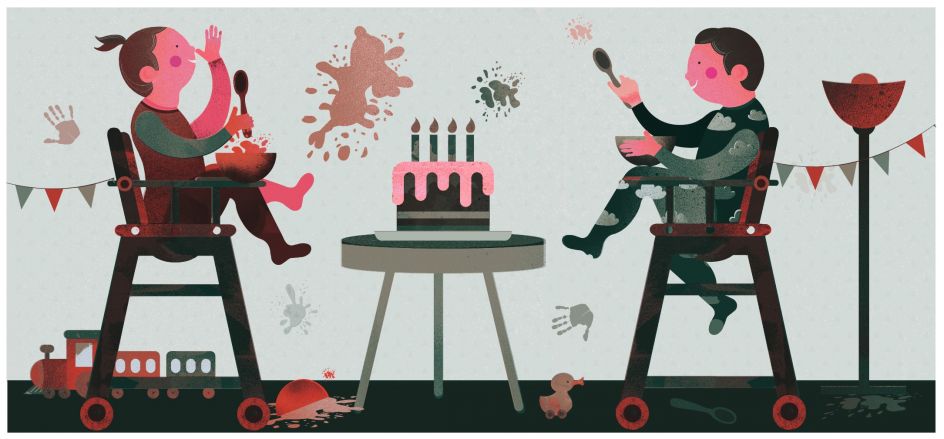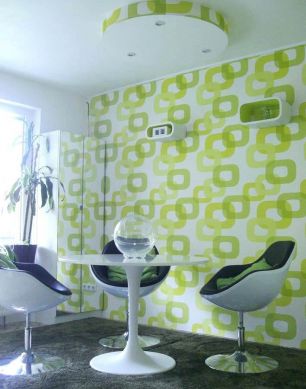Does this image seem familiar? These two tiny tots, Maxi and Moritz, are thoroughly enjoying their birthday party, and as a result, not all of the delicious birthday treats end up in the mouth - some of them soon adorn the walls. We have a solution to prevent you from becoming an instant party pooper: washable wallpapers.
Washable wallpaper is incredibly practical and convenient, and it is most useful in busy rooms where you entertain. But there are many different versions of this amazing invention, all with varying degrees of cleanability, meaning they should be chosen according to the degree of "mess" you expect in a particular room. We will answer the most common questions regarding washable wallpaper in this article. "What are the differences in terms of washable wallpapers?"
Cleaning classifications for wallpapers
The washable wallpapers in our shop are divided into four categories, according to their cleanability:
- Water-resistant
- Wash-resistant
- Highly wash-resistant
- Scrub-resistant
The wallpaper roll insert shows the respective cleaning classification, identifiable by a variety of wavy line symbols. Washable wallpapers have a specific coating (waterproof resin lacquer, vinyl), which makes it possible to clean the surface without damaging it or harming its appearance. The denser and stronger the coating, the more dirt-resistant the surface, and the higher the degree of washability.
Surfaces treated with a plastic finish - Vinyl wallpapers
In order to achieve cleanability in wallpapers, they are often treated with a plastic coating (mostly polyvinyl chloride - PVC). This can be a coating of resin lacquer, a specific foliation, or a protective vinyl layer. The carrier (or basic) material of these washable vinyl wallpapers is usually of the paper or non-woven variety. Vinyl, paper and non-woven wallpapers are not entirely different types of wallpaper: there are some paper and non-woven types of wall coverings treated with vinyl which can also be called vinyl wallpapers. Structural pattern wallpapers with a foamed polymer or PVC structure are also washable.
1. Water-resistant wallpapers
Water-resistant wallpapers are those types without protective coating. Traces of wet wallpaper paste can be removed with a damp sponge or cloth without damaging the wallpaper. However, the cleanability is limited to (still wet) wallpaper paste, which has to be removed very carefully by dabbing (not rubbing!). Cleaning agents like soapy water cannot be used. In practical terms: Other dirt can't be removed without damaging the surface of the wallpaper. Or, in other words: water-resistant wallpapers are not actually washable. Water-resistant types are often paper-based, their main purpose being decorative. They are most suitable for rooms the walls of which are, based on experience, not very (or not at all) likely to get dirty. These rooms include living rooms, bedrooms and home offices or studies.
2. Wash-resistant wallpapers
Wash-resistant wallpapers are sealed, so recent (water-soluble) stains and dirt on the surface can be wiped off with a damp cloth or sponge and some soapy water. Fat, oil and solvent-based stains cannot be removed. Cleaning agents other than soapy water, and especially abrasive (scrubbing) cleaners cannot be used because the wallpaper surface will be damaged in the process as the coating may not withstand those products. Wash-resistant wallpapers are usually of the non-woven variety, even though there are some paper-based types, too. This type of wallpaper can be used in any room, but we would recommend highly wash-resistant or even scrub-resistant varieties for kitchens and children's rooms.
3. Highly wash-resistant wallpapers
Highly wash-resistant wallpapers are treated with a very dense protective vinyl coating. Recent water-soluble stains can be removed from these types of wallpapers as easily as recent greasy stains, by simply using a damp cloth or sponge. The only cleaning agent that should be used is soapy water. As with water-resistant wallpapers, you should proceed with care and avoid rubbing or scrubbing the surface of highly wash-resistant wallpapers. Do not use brushes to remove stains. Highly wash-resistant wallpaper can be used in wet rooms like bathrooms and kitchens, as well as in very busy areas like corridors, landings, along staircases or in kids' rooms.
4. Scrub-resistant/highly scrub-resistant wallpapers
A soft brush can be used to clean scrub-resistant wallpapers with a thick vinyl coating. The coating of scrub-resistant wallpaper types is so strong that the surface can be cleaned with a brush or even a mild abrasive cleaner for water-soluble or grease and fat stains. Don't take the term "scrub-resistant" too literally! These wallpapers should be cleaned as carefully and gently as other types. Highly scrub-resistant wallpapers offer the highest degree of washability, and they will survive even intense cleaning undamaged. Scrub-resistant and highly scrub-resistant wallpapers are a good option for the kitchen, where the risk of spills and contamination is the highest.

Tips for cleaning washable wallpapers
To ensure that you will enjoy your washable wallpapers for a very long time, even after cleaning them with water, cloths, sponges or brushes, as well as soapy water or a mild scrubbing detergent, we have a few handy tips for you:
Use a paper towel to wipe off the damp stain as soon as you can (the earlier you catch it, the better). Then use a damp cloth or sponge and clean the area repeatedly with gentle dabbing movements. Avoid rubbing or too much pressure.
When using a microfibre cloth to clean a washable wallpaper, you do not need to use soapy water as these cloths are specifically designed to absorb dirt.
The term "soapy water" can be interpreted in a number of different ways. Some people understand it to be a mixture of lukewarm water and washing up liquid, others use actual household soap and mix it with water, while others yet choose water and laundry detergent. So what is the right mix, and, more to the point, what is best for washable wallpapers? To make your own soap solution, you can use a mild washing up liquid as well as household soap or laundry detergent. Whatever variety you choose, use it very sparingly and make sure that the laundry detergent (if used) doesn't contain a bleaching agent. In our experience, a mild laundry detergent is the best choice. Never just put the cleaning or scrubbing agent directly onto your cloth or sponge. Dissolve it in warm water before you apply it to the wall.
If you need to clean large areas of your washable wallpaper (for instance in the bathroom, kitchen, hall, stairway), you can use a mop with a telescopic handle and exchangeable cloths to carefully and gently wipe the walls down.
Solvent-based cleaning products can damage the coating by literally dissolving it. Look out for products that do not contain turpentine or acetone. Consequently, certain stains (e.g. from ball pens, highlighters and nail varnish) are tricky to remove, even from washable wallpapers. One possible solution are specific wallpaper "erasers" which are dampened with a small amount of water and then used like a little sponge. However, these "dirt erasers" are not suitable for wallpapers with a high gloss finish. You can try to prevent those stains in your children's room by providing them with water-soluble paints and pencils/crayons and ban ball pens, highlighters and the like. Remove nail varnish splashes on your bathroom wallpaper immediately with a damp cloth.
Don't experiment with grandmother's household remedies on your washable wallpapers. Even though you will find hundreds of those on the internet, we would advise you against them as you can really cause some damage on your precious wall covering when using specific substances or methods. The best solution is to always adhere to the cleaning instructions for your specific wallpaper.
Water resistance and the indoor environment
Washable wallpapers with a sealed or coated surface provide the huge advantage of not absorbing water, which means they can be wiped down with a damp cloth or sponge. However, the nature and use of some rooms (bathroom, kitchen) leads to high levels of humidity, which will remain on the surface of the wallpaper, thus increasing the humidity in the room. The general rule is: Rooms with washable wallpapers should be ventilated often and thoroughly in order to maintain an ideal indoor environment and prevent mould.







